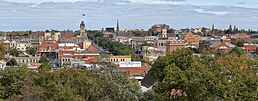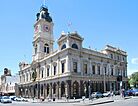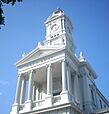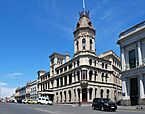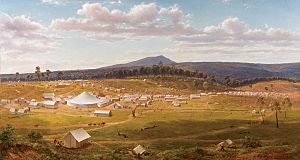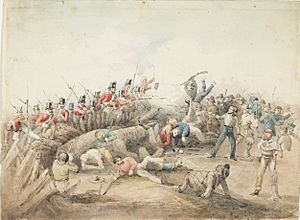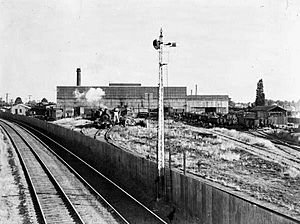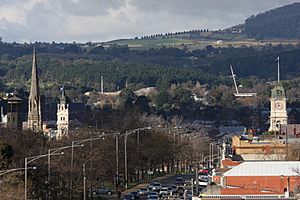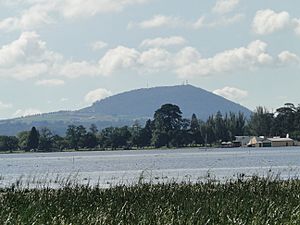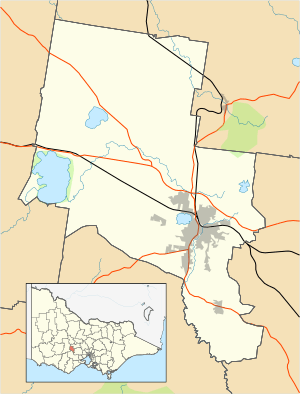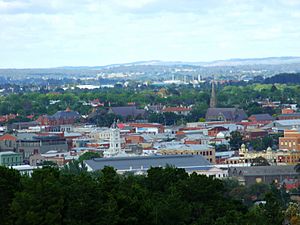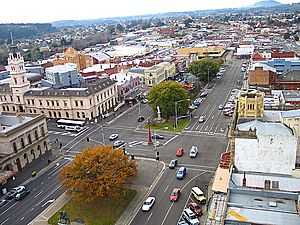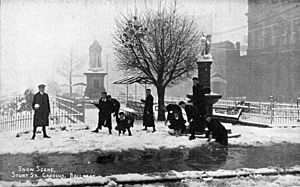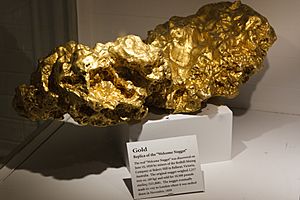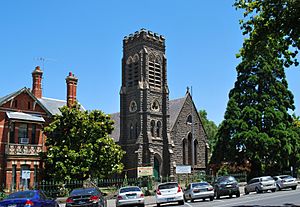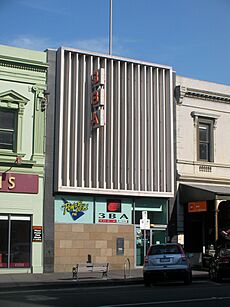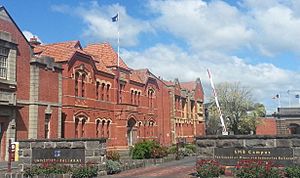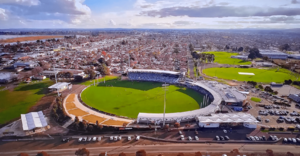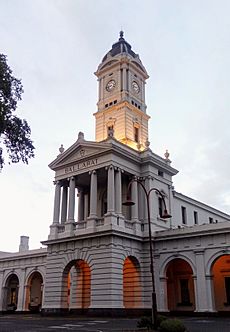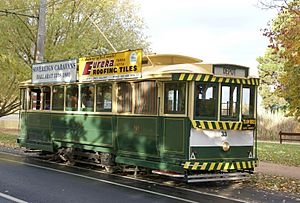Ballarat facts for kids
Quick facts for kids BallaratVictoria |
|||||||||
|---|---|---|---|---|---|---|---|---|---|
|
|
|||||||||
| Population | 119,096 (2024) (19th) | ||||||||
| • Density | 346.61/km2 (897.7/sq mi) | ||||||||
| Established | 1838 | ||||||||
| Postcode(s) | 3350 | ||||||||
| Elevation | 435–630 m (1,427–2,067 ft) AHD | ||||||||
| Area | 343.6 km2 (132.7 sq mi)(2016 census – SUA) | ||||||||
| Time zone | AEST (UTC+10) | ||||||||
| • Summer (DST) | AEDT (UTC+11) | ||||||||
| Location | |||||||||
| LGA(s) | City of Ballarat | ||||||||
| Region | Grampians | ||||||||
| State electorate(s) |
|
||||||||
| Federal Division(s) | Ballarat | ||||||||
|
|||||||||
Ballarat (pronounced BAL-ə-RAT) is a city in the Central Highlands area of Victoria, Australia. It's home to about 119,000 people (as of March 2024). This makes it the third-largest city in Victoria and the third-largest inland city in Australia.
Ballarat became famous in 1851 when gold was found nearby. This started the Victorian gold rush, bringing many people to the area. For a while, Ballarat was almost as rich and important as Melbourne, Victoria's capital city. In 1854, miners in Ballarat started an armed uprising called the Eureka Rebellion. This happened because they were unhappy about gold licenses. The rebellion led to important changes, like allowing white men to vote in Australia. Because of this, the Eureka Rebellion is seen as a key moment in the history of Australian democracy. The Eureka Flag, which was used by the miners, is now a national symbol.
Ballarat officially became a city in 1870. Unlike many other gold rush towns, Ballarat stayed wealthy for a long time because its goldfields kept producing a lot of gold. By the early 1900s, gold mining slowed down, and Melbourne became much more important. However, Ballarat has remained a major regional centre. It's the main business city of the Central Highlands and a popular place for tourists. People love Ballarat for its rich history, culture, and beautiful old buildings from the colonial era. Many parts of the city are protected because of their historical importance.
Contents
- Ballarat's Story: A Golden Past
- Ballarat's Landscape: Geography
- Ballarat's Weather: Climate
- Nature and Environment
- Ballarat's Economy: How People Work and Live
- People of Ballarat: Demographics
- How Ballarat is Run: Governance
- News and Entertainment: Media
- Learning and Knowledge: Education
- Arts and Culture: Creativity in Ballarat
- Sports and Fun: Recreation
- City Services: Infrastructure
- Ballarat's Suburbs
- Getting Around: Transportation
- See also
Ballarat's Story: A Golden Past
Early Days and European Arrival
Before Europeans came to Australia, the Ballarat area was home to the Wathaurong people. They are an Indigenous Australian group whose land was along the Yarrowee River.
The first Europeans to see the area were a group of Scottish settlers in 1837. They were looking for new land for their sheep. Two brothers, Archibald and William Yuille, arrived in 1837 and set up a large sheep farm. The first simple houses were built around 1838. Archibald Yuille named the area "Ballaarat." It's believed this name came from a local Wathaurong word, balla arat, which might mean 'resting place'. The spelling was officially changed to "Ballarat" in 1996.
The Gold Rush Era: 1850s
Gold was first publicly found near Ballarat by Thomas Hiscock on August 2, 1851. Soon after, on August 19, John Dunlop and James Regan found more gold at Poverty Point. This news quickly started a huge gold rush! Thousands of people, called prospectors, rushed to the Yarrowee valley, which became known as the Ballarat diggings.
The amount of gold found was amazing. Early prospectors could find enough gold in a day to earn more than a week's average wage! As word spread, Ballarat became known worldwide as a very rich goldfield. Many immigrants came, including people from Ireland and China. They lived in temporary towns made of tents and shacks. Within months, the population grew to over 1,000 people.
The first Post Office opened in November 1851. It was the first post office in a gold-mining town in Victoria. By 1852, the new town of West Ballarat was planned with wide, straight streets. This was very different from the messy, unplanned streets of the original East Ballarat settlement. The main streets were named after important police and gold officials of the time.
A big event in Ballarat's history was the Eureka Rebellion, also called the "Eureka Stockade." This happened on December 3, 1854. Miners were unhappy with the government's gold licenses and fought against government forces. Sadly, 22 miners were killed. This event is very important in Australian history because it helped lead to fairer voting rights for men.
Ballarat earned the nickname "The Golden City" during the 1850s. At its peak, the gold rush population reached almost 60,000 people. However, many miners moved on quickly when new goldfields were discovered. By 1859, about 23,000 people stayed. Many of them had become wealthy from gold and started a strong economy based on deep underground gold mining.
The people of Ballarat believed their city would last. They built large public buildings, beautiful parks, and fancy homes and businesses. A local industry for building steam locomotives started in 1854. The railway arrived in 1862, making Ballarat an important railway town.
Ballarat as a Victorian City
From the late 1860s to the early 1900s, Ballarat changed from a gold rush town to an industrial city. The temporary tents and wooden buildings were replaced by strong stone and brick structures. These impressive buildings were mostly paid for by the wealth from gold mining.
Prince Alfred, Duke of Edinburgh, visited Ballarat in December 1867. This was the first royal visit, and it was a huge celebration. The city's first community centre, Prince Alfred Hall, was named after him.
Ballarat was officially declared a city in 1871. A large reservoir, Gong Gong, was built in 1877 to help with floods and provide a steady water supply. A direct railway line to Melbourne was finished in 1889. Many factories and workshops were set up to support the deep gold mining industry.
Around the early 1900s, people started calling Ballarat the "Athens of Australia." This nickname was given by a famous Irish-Australian judge, Sir John Madden.
In 1901, the Duke of York (who later became King George V) and his wife, Mary, visited Ballarat by train. The city's first electricity supply was also completed in 1901.
Changing Times: 20th Century Challenges
After the early 1900s, gold mining slowed down, and Ballarat's growth almost stopped. The city went through a period where it wasn't as wealthy as before.
A sad event was the Sunshine rail disaster in 1908, which killed many Ballarat residents. In 1909, a big storm hit the city, causing damage and injuries. A tornado even swept through some northern and eastern suburbs, destroying homes.
One positive development was the opening of the Ballarat North Workshops in 1917. These workshops were a major railway manufacturing centre. The Great Depression in the 1930s was another tough time for Ballarat, leading to high unemployment.
In 1921, the two main parts of the city, Ballarat East and West, joined together to form the City of Ballarat.
Growth and Modern Ballarat
After the Great Depression, Ballarat started to recover. New projects like a sewerage system were built. In 1930, Ballarat Airport was created. By 1931, the city's economy and population were growing again. During World War II, the expanded Ballarat airport was an important base for the RAAF and the USAAF. In 1942, Ballarat was connected to the state electricity grid.
After the war, Ballarat continued to grow. Many new houses were built to help with a housing shortage. A large housing area was developed in what is now Wendouree West.
The 1950s brought new excitement. In 1952, it was announced that Lake Wendouree would host the rowing events for the 1956 Summer Olympics. The first Begonia Festival, a popular community event, was held in 1953. Elizabeth II visited in 1954. A new Civic Hall was built and opened in 1955. On November 23, 1956, the Olympic torch was carried through the city, and the rowing events took place the next day. The Queen Mother also visited in 1958.
In the 1970s, Ballarat began to officially recognize its important historical buildings. Sovereign Hill, a recreated gold mining town, opened in 1970. This helped Ballarat become a major tourist destination. Charles, Prince of Wales, visited Ballarat in 1974 and toured Sovereign Hill.
Ballarat has continued to grow in recent decades. In 2008, a plan was made to focus the city's growth to the west. This plan, approved in 2010, includes building 14,000 new homes and adding up to 40,000 new residents.
Military History
During World War II, Ballarat was home to the RAAF No.1 Inland Aircraft Fuel Depot. This was a special place built in 1942 to store fuel for aircraft used by the RAAF and the US Army Air Forces. It closed in 1944.
Ballarat's Landscape: Geography
Ballarat is located at the base of the Great Dividing Range in Central Western Victoria. This area is known as the Central Highlands because it has gentle hills instead of tall mountains. The city sits on mostly flat land that stretches out from nearby towns.
The land around Ballarat was formed by ancient rivers and volcanoes that are now extinct, like Mount Buninyong and Mount Warrenheip. This means the soil is very fertile and good for farming. Ballarat itself is in a valley formed by the Yarrowee River and its smaller streams. There are also underground water sources and natural wetlands.
There are many forests around Ballarat, but none of the very old, original forests remain due to past logging. Important natural water bodies include Lake Wendouree in the west, which is central to the city's western suburbs, and the larger Lake Burrumbeet. Many other lakes in the area were made by people, like the White Swan Reservoir.
The main urban area of Ballarat covers about 90 square kilometres. Most of this land is used for homes. From the city centre, the urban area stretches several kilometres in all directions. The central city is low in the Yarrowee River valley, surrounded by hills. This means you can only see the city skyline from higher areas. The Yarrowee River actually flows under the city centre in a covered drain.
City Layout and Suburbs
Ballarat is mostly a city with low-rise buildings. The City of Ballarat has two main activity centres: the Central Business District (CBD) and Wendouree. These areas have many businesses, shops, and community services. There are also 11 smaller neighbourhood centres. The tallest building in Ballarat is the seven-storey Henry Bolte wing of the Ballarat Base Hospital.
Beyond the city centre, Ballarat has many suburbs with different types of houses. You can find 19th-century villas, Victorian terraces, and red brick homes. Small villages and country towns are also found around Ballarat.
The Central Business District (in Ballarat Central) is a large area with offices and shops. It's known for its historic buildings along streets like Lydiard, Sturt, and Bridge Street (Bridge Mall).
The older suburbs were built around the gold mining areas. These include Ballarat East, Bakery Hill, Golden Point, and Soldiers Hill.
After the gold rush, Ballarat expanded a lot. New suburbs like Lucas, Alfredton, and Delacombe grew to the west. To the north, areas like Wendouree and Miners Rest expanded. To the east, Warrenheip grew, and to the south, Sebastopol and Mount Helen expanded.
Wendouree has the only large indoor shopping mall, Stockland Shopping Centre. Other suburbs have smaller shopping areas with supermarkets.
Ballarat doesn't have a strict boundary for urban growth. This means the city council often approves new housing developments outside the city's current edge. A big plan called the Ballarat West Growth Area Plan will allow for 14,000 new homes and up to 40,000 new residents, almost doubling the city's urban area.
Ballarat's Weather: Climate
Ballarat has a moderate oceanic climate with four clear seasons. Because it's high up (435 to 630 metres above sea level), its temperatures are usually 3 to 5 degrees Celsius cooler than Melbourne's, especially in winter. January's average high is 25.1°C, and its average low is 10.9°C. In July, the average high is 10.0°C, and the average low is 3.2°C. Ballarat has about 55 clear days each year, mostly in summer and early autumn. Winters are quite rainy.
Ballarat is known for its changeable and sometimes extreme weather, from snow to heatwaves. The cold winters are famous, often made colder by strong winds. Ballarat is actually the coldest city in Victoria when you look at average temperatures.
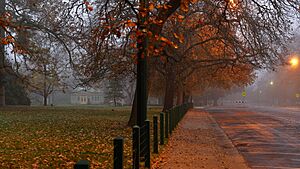
Temperatures can drop below freezing from May to September, but usually stay around 0-2°C. Frost and fog are common in cooler months. Light snow often falls on nearby Mount Buninyong and Mount Warrenheip a few times a year. In the city itself, snow falls only once or twice during heavy winters. Sometimes, heavy snow can cover the city centre. Big snow seasons happened in the early 1900s and 1940s/1980s. More recently, snow has fallen in the city in 2006, 2007, 2008, 2014, 2016, 2017, 2018, 2019, and 2020.
The average yearly rainfall is 693 mm, with August being the wettest month (about 75 mm). There are about 198 days without rain each year. Like many parts of Australia, Ballarat has periods of drought and heavy rain. The Yarrowee River sometimes floods. In 1869, a serious flood covered much of the business district and caused two deaths. A long drought from 2001 caused Lake Wendouree to dry up completely between 2006 and 2007. More recently, there have been heavy rains, including 95 mm in one day in January 2011, making it the wettest January on record.
Ballarat is one of the windiest cities in Australia. This means warm summers feel cooler, and cold winter days feel even colder due to the wind chill.
The highest temperature ever recorded in Ballarat was 44.1°C on February 7, 2009, during a heatwave. The lowest temperature ever recorded was -6.0°C on July 21, 1982.
| Climate data for Ballarat (Ballarat Aerodrome 1908-2016) | |||||||||||||
|---|---|---|---|---|---|---|---|---|---|---|---|---|---|
| Month | Jan | Feb | Mar | Apr | May | Jun | Jul | Aug | Sep | Oct | Nov | Dec | Year |
| Record high °C (°F) | 42.0 (107.6) |
44.1 (111.4) |
37.9 (100.2) |
31.5 (88.7) |
26.1 (79.0) |
21.6 (70.9) |
19.1 (66.4) |
23.0 (73.4) |
27.9 (82.2) |
33.4 (92.1) |
37.3 (99.1) |
40.6 (105.1) |
44.1 (111.4) |
| Mean daily maximum °C (°F) | 25.1 (77.2) |
25.1 (77.2) |
22.2 (72.0) |
17.7 (63.9) |
13.7 (56.7) |
10.8 (51.4) |
10.1 (50.2) |
11.4 (52.5) |
13.9 (57.0) |
16.7 (62.1) |
19.7 (67.5) |
22.6 (72.7) |
17.4 (63.3) |
| Mean daily minimum °C (°F) | 10.9 (51.6) |
11.5 (52.7) |
10.0 (50.0) |
7.5 (45.5) |
5.7 (42.3) |
4.0 (39.2) |
3.2 (37.8) |
3.7 (38.7) |
4.8 (40.6) |
6.2 (43.2) |
7.8 (46.0) |
9.4 (48.9) |
7.1 (44.8) |
| Record low °C (°F) | 0.7 (33.3) |
−1.4 (29.5) |
−0.6 (30.9) |
−4.1 (24.6) |
−4.5 (23.9) |
−4.6 (23.7) |
−6.0 (21.2) |
−5.0 (23.0) |
−4.6 (23.7) |
−3.6 (25.5) |
−1.0 (30.2) |
−1.0 (30.2) |
−6.0 (21.2) |
| Average precipitation mm (inches) | 39.4 (1.55) |
44.0 (1.73) |
42.3 (1.67) |
50.8 (2.00) |
64.0 (2.52) |
62.7 (2.47) |
66.6 (2.62) |
74.2 (2.92) |
72.0 (2.83) |
66.5 (2.62) |
55.5 (2.19) |
50.1 (1.97) |
689.4 (27.14) |
| Average rainy days | 7.7 | 7.2 | 9.5 | 12.5 | 16.2 | 17.9 | 19.9 | 19.5 | 16.7 | 15.4 | 12.7 | 10.9 | 166.1 |
| Average relative humidity (%) | 42 | 44 | 48 | 57 | 69 | 76 | 75 | 70 | 63 | 59 | 54 | 47 | 59 |
| Climate data for Ballarat (Ballarat Airport), elevation 435 m (1,427 ft), (1991–2020 normals, extremes 1951–present) | |||||||||||||
|---|---|---|---|---|---|---|---|---|---|---|---|---|---|
| Month | Jan | Feb | Mar | Apr | May | Jun | Jul | Aug | Sep | Oct | Nov | Dec | Year |
| Record high °C (°F) | 42 (108) |
44.1 (111.4) |
37.9 (100.2) |
32.2 (90.0) |
26.1 (79.0) |
21.6 (70.9) |
19.1 (66.4) |
23.0 (73.4) |
27.9 (82.2) |
33.4 (92.1) |
37.3 (99.1) |
43.5 (110.3) |
44.1 (111.4) |
| Mean daily maximum °C (°F) | 26.2 (79.2) |
25.7 (78.3) |
22.9 (73.2) |
18.4 (65.1) |
14.2 (57.6) |
11.3 (52.3) |
10.5 (50.9) |
11.8 (53.2) |
14.1 (57.4) |
17.3 (63.1) |
20.5 (68.9) |
23.4 (74.1) |
18.0 (64.4) |
| Mean daily minimum °C (°F) | 11.6 (52.9) |
11.6 (52.9) |
9.9 (49.8) |
7.0 (44.6) |
5.1 (41.2) |
3.6 (38.5) |
3.0 (37.4) |
3.1 (37.6) |
4.4 (39.9) |
5.9 (42.6) |
8.0 (46.4) |
9.4 (48.9) |
6.9 (44.4) |
| Record low °C (°F) | 0.7 (33.3) |
−1.4 (29.5) |
−0.6 (30.9) |
−4.1 (24.6) |
−4.5 (23.9) |
−4.6 (23.7) |
−6.0 (21.2) |
−5.0 (23.0) |
−4.6 (23.7) |
−3.6 (25.5) |
−1.0 (30.2) |
−1.0 (30.2) |
−6.0 (21.2) |
| Average rainfall mm (inches) | 45.1 (1.78) |
39.5 (1.56) |
31.5 (1.24) |
42.4 (1.67) |
50.4 (1.98) |
60.2 (2.37) |
61.4 (2.42) |
66.5 (2.62) |
69.2 (2.72) |
53.8 (2.12) |
54.5 (2.15) |
46.2 (1.82) |
620.9 (24.44) |
| Average rainy days (≥ 1.0 mm) | 5.2 | 4.1 | 5.1 | 7.1 | 9.1 | 11.5 | 12.6 | 12.6 | 11.3 | 9.3 | 7.4 | 6.2 | 101.5 |
| Average afternoon relative humidity (%) (at 3 P.M.) | 42 | 44 | 48 | 57 | 69 | 76 | 75 | 70 | 63 | 59 | 54 | 47 | 59 |
| Average dew point °C (°F) | 10.0 (50.0) |
10.7 (51.3) |
9.7 (49.5) |
8.2 (46.8) |
6.9 (44.4) |
5.3 (41.5) |
4.2 (39.6) |
4.5 (40.1) |
5.6 (42.1) |
6.7 (44.1) |
7.9 (46.2) |
8.7 (47.7) |
7.4 (45.3) |
| Source: Australian Bureau of Meteorology (Dew point at 9 A.M.) | |||||||||||||
Nature and Environment
Parks and Natural Areas
Ballarat is surrounded by lots of bushland to the north, south, and southwest. There are also important wetlands to the east. The biggest park in the city is Victoria Park, which has many sports fields, playgrounds, and walking tracks.
There are also several state parks and large reserves nearby. These include Enfield State Park, Creswick Regional Park, and the Mount Warrenheip and Mount Buninyong Reserves. Smaller parks like Black Hill and Pioneer Park are close to the city centre.
Ballarat is special because it has kept much of its "commons" land. This land can be used by any resident of Ballarat. The Ballarat Town Common is a great place for dog walkers and people who enjoy nature.
The area is also home to many koalas, with special protected areas in the outer southern and eastern parts of the city.
Environmental Efforts
The air quality in Ballarat is usually good. However, dust can be a problem in summer, and smoke from fireplaces can reduce visibility in winter. Ballarat's waterways have been affected by pollution from mining and industry in the past.
Groups like the Ballarat Environment Network work to protect nature in Ballarat. Another group, BREAZE, focuses on sustainability and renewable energy. The City of Ballarat also has a plan to help the environment.
Some plants and animals that are not native to Australia have caused problems in Ballarat. For example, Common gorse is a weed that is being controlled. European rabbits and red foxes also cause damage to farms in the region.
Ballarat's Economy: How People Work and Live
Ballarat's economy involves many different types of jobs. Today, it's mostly a service economy. This means many people work in tourism, hotels and restaurants, shops, and in government or education. Manufacturing (making things) is also important. While mining and agriculture were once very big, they play a smaller role now. New industries like information technology and renewable energy are growing.
Service Jobs
Ballarat is a major centre for the goldfields region, so many people work in services. This includes jobs in shops, professional services (like lawyers or accountants), and trades (like plumbers or electricians). There are also many jobs in government offices, health care, and other service organisations. These jobs make up more than half of the city's workforce and create most of its economic activity.
Ballarat is the main shopping hub in the region. It has several shopping areas, including the Bridge Mall, which is a pedestrian mall with over 100 shops. There are also large indoor shopping malls like Central Square Shopping Centre and Stockland Wendouree. Big department stores like Myer, Target, and Kmart are here. All the major supermarkets are also present.
Federation University Australia is a big part of the education sector. It teaches many international students and offers online courses across Australia.
In recent years, the Ballarat Technology Park has been built. It has companies like IBM and employs over 1,400 people in the information technology sector.
The Ballarat West Employment Zone (BWEZ) is a new area being developed for jobs and economic growth. It's near the airport and railway, making it good for industries, storage, and transport. Businesses here include those in agriculture, labs, and transport.
Tourism and Hospitality
Ballarat attracts about 2.2 million visitors every year. The tourism and hospitality industry brings in about A$480 million a year and employs around 2,870 people.
A big part of Ballarat's tourism is its history. The most famous attraction is Sovereign Hill, an award-winning open-air museum. It's a recreated gold mining town from the 1850s and opened in 1970. Sovereign Hill is Ballarat's biggest draw, bringing in over half a million visitors and $40 million in tourism money each year.
Other places that celebrate Ballarat's gold mining history include Kryal Castle and "Gold Rush Mini Golf."
Other popular tourist spots are the Eureka Centre, The Gold Museum, Ballarat, Ballarat Botanic Gardens, and Ballarat Wildlife Park. Many hotels, motels, and restaurants serve the tourists.
Ballarat also hosts many yearly festivals, like the Ballarat Begonia Festival and Ballarat Heritage Weekend.
Manufacturing: Making Things
In 2021, manufacturing was Ballarat's sixth largest job sector, employing 7% of all workers.
Several international companies have factories in Ballarat. Mars, Incorporated has its Australian headquarters here and makes popular chocolates like Mars bars and Snickers. McCain Foods Limited also has its Australian headquarters in Ballarat and continues to grow its operations. The Ballarat North Workshops make products for public transport, with current investment from Alstom.
Ballarat also has many local companies that make textiles, engineering parts, food products, bricks, and building materials. Brewing beer used to be a big industry, and now there are many smaller local breweries.
Primary Industries: Farming and Mining
While gold mining was once huge in Ballarat, it's not as important to the economy today. Agriculture (farming) is now the main primary industry. Together, farming and mining employ only about 2% of Ballarat's workers.
Even though gold mining is much smaller, deep underground mining still happens today with one main mine. People believe there might still be large amounts of gold hidden in the Ballarat area. Companies like Boral Limited also extract and make building materials like clay and stone from the region.
About half of Ballarat's area is rural, with good conditions for farming. This land is mainly used for growing crops and raising animals. It produces over $37 million in goods. Ballarat is known for its potato farms, which supply food manufacturers. Other crops include grains, vegetables, grapes, and berries. Raising cattle, sheep, and pigs supports local meat and dairy industries. The Ballarat Livestock Selling Centre is the biggest cattle market in regional Victoria. The Ballarat Agricultural and Pastoral Society has held the Ballarat Show every year since 1859.
A forestry industry, worth A$7.5 million, operates in nearby state forests and some areas around Mount Clear and Mount Helen.
Renewable Energy
The Ballarat region has a fast-growing renewable energy industry, especially because of its strong winds. This has brought in a lot of investment. The area also has geothermal energy, solar power, and biomass, but mostly wind, solar, and hydroelectricity are used commercially. All the electricity produced locally is sent to the national power grid.
Wind energy comes from local wind farms. The biggest one, Waubra Wind Farm, can produce enough electricity to power a city 3 to 4 times the size of Ballarat. Another large one, Mount Mercer Wind Farm, can power 100,000 homes, which is about Ballarat's population. The first community-owned wind farm in Australia, the Hepburn Wind Project, produces enough electricity for the town of Daylesford.
Hydroelectricity is made at the White Swan reservoir micro hydro plant, which opened in 2008. It produces enough electricity for about 370 homes. The Ballarat Solar Park, opened in 2009 at the Airport site, is Victoria's first large ground-mounted solar farm. It generates electricity for about 150 homes.
People of Ballarat: Demographics
Ballarat is the 4th largest inland city in Australia and the 3rd largest city in Victoria (after Melbourne and Geelong). In 2021, Ballarat had 111,973 people. This number has been growing steadily, especially because housing in Melbourne has become very expensive, and public transport to Melbourne has improved.
Most people in Ballarat have ancestors from England, Scotland, or Ireland. However, 16.3% of the population were born overseas. This includes people from England (2.1%), India (1.6%), New Zealand (0.9%), China (0.6%), and the Philippines (0.6%). About 8.2% of people speak a language other than English at home. The average age in Ballarat is 38 years old.
Ballarat's diverse population is partly due to the gold rush in the mid-1800s. Many people from different backgrounds came hoping to find gold.
The average income in Ballarat in 2019-2020 was about A$50,767. Many people work as professionals, in community services, as technicians or trades workers, or in office jobs. The unemployment rate in 2021 was 4.8%. About 21.9% of the population have continued their education after high school.
Christianity is the most common religion in Ballarat. The largest Christian groups are Catholics (21.3%), Anglicans (7.9%), and the Uniting Church (4.7%). About 47.6% of people said they had no religion.
How Ballarat is Run: Governance
The City of Ballarat is governed from the Council Chamber in Ballarat Town Hall. The council was formed in 1994 by combining several smaller local areas. The city is divided into 3 areas called wards, and each ward has three councillors. These councillors are elected every four years. The Mayor of Ballarat, currently Des Hudson, is chosen by the councillors for a one-year term.
In state politics, Ballarat is part of the Eureka and Wendouree districts. Both of these are currently held by the Australian Labor Party. In federal politics, Ballarat is in the Division of Ballarat. This area has been held by the Australian Labor Party since 2001. It was also the area represented by Alfred Deakin, who was the second Prime Minister of Australia.
Law enforcement is managed from the regional police headquarters in Dana Street. There is also a local police station in Buninyong. The city's courts, including the Supreme, County, Magistrates, and Children's Courts, are also located in Dana Street.
Public safety and emergency services are provided by state-funded and volunteer groups. The State Emergency Service (SES) handles storms and floods. The Country Fire Authority (CFA) deals with bushfires, and urban fire brigades handle city fires. Ambulance Victoria provides medical emergency services. The City of Ballarat also has a committee that plans for emergencies.
News and Entertainment: Media
Newspapers
Ballarat has two local newspapers. The Courier is a daily newspaper. The Ballarat Times News Group is a free weekly paper given out on Thursdays. It has community news, local advertisements, and classifieds.
Radio Stations
Local radio stations include 3BA, Power FM, and several community radio stations. There is also a Ballarat branch of ABC Local Radio.
- 102.3 FM – 3BA (local "classic hits" commercial radio)
- 103.1 FM – Power FM 103.1 FM (local "top-40" commercial radio)
- 99.9 FM – Voice FM 99.9 (local community radio)
- 107.9 FM – ABC Ballarat (government-funded local news and talk)
- 103.9 FM – Good News Radio 103.9 (Christian community radio)
Television
Ballarat receives many "free to air" digital television channels. Two broadcasting stations are in the city: WIN (which shows programs from the Nine Network) and Seven (which is owned by the Seven Network). These stations broadcast services across regional Victoria. The city also gets channels from Network 10, which is based in Bendigo but has a local office.
Ballarat TV usually follows the national schedule but has local commercials and regional news. WIN used to produce a 30-minute local WIN News bulletin from its Ballarat studios. Now, these bulletins are produced in Wollongong, New South Wales, but WIN still has reporters and camera crews in Ballarat.
In addition to commercial TV, Ballarat also receives government-funded ABC and SBS television services.
In 2011, analog television stopped in regional Victoria, including Ballarat. All local free-to-air TV services now broadcast only in digital.
You can also get subscription television services from companies like Foxtel.
Learning and Knowledge: Education
Ballarat has two universities: Federation University and a campus of the Australian Catholic University.
Federation University Australia opened in 2014. It started as the Ballarat School of Mines in 1870. Its main campus is in Mount Helen, about 6 km southeast of the city. The university also has campuses in the Ballarat CBD and other towns.
The Australian Catholic University's Ballarat campus is on Mair Street. It used to be the Aquinas Training College, started in 1909. It's the only ACU campus outside a capital city.
Ballarat has five public high schools. Ballarat High School (started in 1907) is the oldest. There are also many Catholic schools, including eight primary schools and three high schools. These include the all-boys St Patrick's College, the all-girls Loreto College, and the co-educational Damascus College.
Ballarat has three other private high schools: Ballarat Christian College, Ballarat Clarendon College, and Ballarat Grammar School. These last two schools are known for their excellent academic results. In 2015, Clarendon was ranked 9th best in Victoria for VCE results.
The City of Ballarat has three public libraries. The largest is the Ballarat Library on Doveton Street North. The Ballarat Mechanics' Institute in Sturt Street is the oldest library in the city and has a collection of historic books.
The Xin Jin Shan Chinese Library opened in 2022. It has over 240,000 Chinese-language books, which is reportedly the largest collection in the Southern Hemisphere.
Arts and Culture: Creativity in Ballarat

Art Galleries
The Art Gallery of Ballarat has one of Australia's oldest and largest collections of early Australian artworks. It's the oldest and biggest regional art gallery in Australia.
Federation University Australia also runs the Post Office Gallery in the old Post Office building.
Performing Arts
Ballarat has a very active theatre community with several local groups and large venues. The main places for performing arts include the 900-seat Her Majesty's Theatre, the Wendouree Centre for Performing Arts, and the Post Office Box Theatre.
Some notable theatre groups in Ballarat are Ballarat National Theatre (since 1938) and BLOC (Ballarat Light Opera Company, since 1959).
The Ballarat Civic Hall is a large public building built in 1958. It was closed in 2002 but reopened in 2018 after being renovated into a modern performing arts and exhibition centre. It has a main hall that can hold 1000 people for concerts and events.
The Regent Cinemas, which opened in 1928, was once the biggest picture palace (a grand cinema) in regional Victoria. It had almost 2,000 seats. After a fire in 1943, it was redesigned. It was later refurbished into a multiplex with multiple screens. Sadly, the cinema closed in June 2024.
Ballarat has its own symphony orchestra, the Ballarat Symphony Orchestra, formed in 1987. The city also has many dance clubs and a lively live music scene.
Events and Festivals
Ballarat hosts many annual festivals and events that attract thousands of visitors. The oldest big event is the Ballarat Agricultural Show (since 1859), held at the Ballarat Showgrounds. It attracts up to 30,000 people and is a public holiday for residents.
Ballarat is also home to Australia's oldest and largest yearly performing arts competition, the Royal South Street Eisteddfod. This festival runs for twelve weeks each year.
Lake Wendouree is featured in many events, including the biggest and most famous, the Begonia Festival (held every year since 1953). SpringFest (since 2001) attracts over 15,000 people with market stalls and activities around the lake.
The Ballarat Swap Meet (since 1989) attracts 30,000 visitors a year. Ballarat Heritage Weekend (since 2006) celebrates the city's history with historic vehicles and displays, attracting up to 14,500 visitors. The Ballarat Beer Festival (since 2012) attracts over 4,000 visitors. The Ballarat Airport Open Day also attracts thousands.
Other cultural festivals include the Ballarat Writers Festival and the Ballarat International Foto Biennale.
Sports and Fun: Recreation
Ballarat Highlanders Rugby Football Club (started 1976) is based at Doug Dean Reserve. They play in the Victoria Rugby Championship. They also host the Ballarat Charity 7s, which raises money for local charities.
Australian rules football is the most popular sport in Ballarat, both to watch and play. It has its own stadium, Eureka Stadium, which hosts Australian Football League (AFL) games. It's also the home ground for the North Ballarat Roosters. The Ballarat Football League, started in 1893, has six local teams, including the Ballarat Football Club, which is one of the world's oldest football clubs.
Cricket is the second most popular sport. Ballarat has three international standard cricket ovals, including Eastern Oval, which hosted games for the 1992 Cricket World Cup. Soccer is also popular. The Ballarat City FC team plays in the National Premier League. Melbourne's Western United FC also plays some A-League matches at Eureka Stadium. Basketball is played at the Ballarat Sports Events Centre, home to the Ballarat Miners and Ballarat Rush teams. Netball is also very popular.
Athletics has always been popular in Ballarat. The city has a rich history with many Olympians, like Jared Tallent and Steve Moneghetti, coming from Ballarat.
Rowing and kayaking are popular on Lake Wendouree. The lake hosts the Victorian Schools Rowing Championships and the yearly "Head of the Lake" rowing event. Ballarat hosted the rowing events for the 1956 Summer Olympic Games. Horse racing and greyhound racing are also popular, with special facilities. The Ballarat Turf Club holds about 28 race meetings a year.
Golf is played at four main courses, including the Ballarat Golf Course. The Ballarat Roller Derby League was formed in 2008.
The World Athletics-Certified Ballarat Marathon Road Running Festival started in 2024. It's now a yearly event with different running races, including a full marathon. It attracts people from all over and showcases Ballarat's beautiful landmarks.
Ballarat was planned to host some events for the 2026 Commonwealth Games before they were cancelled. Eureka Stadium was going to host athletics, Eastern Oval T20 cricket, and Selkirk Stadium boxing.
City Services: Infrastructure
Ballarat's residents have access to many public services like water, gas, electricity, phones, and internet. These are provided by state groups and private companies.
Water is supplied by Central Highlands Water. Drinking water comes from reservoirs in the eastern highlands, mainly Lal Lal and White Swan. Lal Lal Reservoir is Ballarat's largest water source. Since 2008, White Swan has also received water from Bendigo through the Goldfields Superpipe. Older reservoirs like Kirks and Gong Gong are kept for emergencies. Sewage is managed by two treatment plants.
Electricity is supplied by Powercor, and natural gas by AGL Energy.
Phone services are provided by Telstra and Optus. The city's mobile network uses modern technology. Internet access is available through ADSL services from main exchanges. Ballarat is also getting the National Broadband Network (NBN), which will connect many homes directly with optical fibre cable. This is important for the city's growing IT industry.
Ballarat's Suburbs
Ballarat has many suburbs, including:
Addington, Alfredton, Ascot, Bakery Hill, Ballarat Central, Ballarat East, Ballarat North, Black Hill, Blowhard, Bonshaw, Brown Hill, Bunkers Hill, Canadian, Cardigan, Cardigan Village, Chapel Flat, Coghills Creek, Delacombe, Eureka, Glendaurel, Glendonald, Golden Point, Gong Gong, Invermay Park, Lake Gardens, Lake Wendouree, Learmonth, Lucas, Magpie, Miners Rest, Mitchell Park, Mount Bolton, Mount Clear, Mount Helen, Mount Pleasant, Mount Rowan, Nerrina, Newington, Redan, Scotchmans Lead, Sebastopol, Soldiers Hill, Tourello, Weatherboard, Wendouree, Windermere and Winter Valley.
Getting Around: Transportation

Most people in Ballarat travel by car. A network of state highways connects Ballarat to other places. The Western Freeway bypasses the city and provides a direct road to Melbourne (about 90 minutes away) and to Ararat and Horsham in the west. The Midland Highway goes north to Creswick and south to Geelong. Other highways connect to Mount Gambier and Mildura. Sturt Street and Victoria Street are busy main roads in the city centre.
Trains
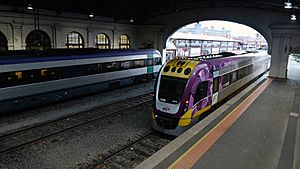
Ballarat is a major train hub in Victoria. It's where several train lines meet. The city has two passenger train stations: the main Ballarat railway station and the suburban Wendouree railway station. From Ballarat station, V/Line trains go to Melbourne, west to Ararat, and north to Maryborough.
Trains to Melbourne now take at least 73 minutes. The Regional Rail Link project, built in 2015, helped separate Ballarat trains from Melbourne's local train network. Trains between Ballarat and Melbourne now run every half-hour during busy times and hourly at other times. There are also daily services to Ararat and Maryborough. Victoria's electronic ticketing system, Myki, was introduced for train services between Wendouree and Melbourne in 2013. Ballarat is also connected to Geelong by a freight-only railway line.
Buses
CDC Ballarat runs the bus network in the city. Buses cover the city centre, the train stations, and most suburbs.
Trams
Ballarat used to have a large tram network that operated until 1971. A small part of the track is now used for a tourist and museum tramway. There have been ideas to extend the tram network again, especially for tourists, but these plans have not gone ahead.
Airport
Ballarat Airport is about 8 km northwest of the city centre. It has two sealed runways. Plans for the airport include making the main runway longer and wider, and possibly expanding the passenger terminal. In 2020, funding was provided to rebuild the main north-south runway to 1900 metres.
Cycling and Walking
Ballarat has a long history of cycling. The city's cycling network is growing and includes marked on-road routes and 50 km of segregated bicycle facilities (paths just for bikes). Main routes include the Ballarat–Skipton Rail Trail and the Yarrowee River Trail. The Ballarat Bicycle Users Group supports cyclists in the city. Many people also come to Ballarat for cycling events.
See also
 In Spanish: Ballarat para niños
In Spanish: Ballarat para niños


